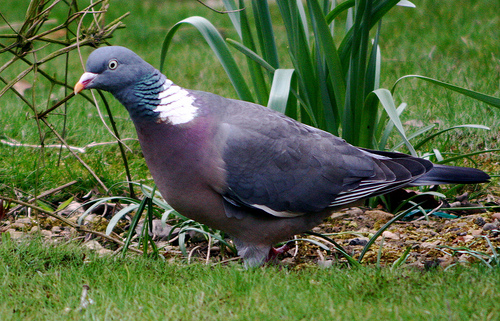| New Photos | Animal News | Animal Sounds | Animal Movies | Upload Photo | Copyright | Korean |
|---|
| Funny Animal Photos | Monsters in Animalia | Wiki Articles Fun Facts about Animals | Links | Home | Mobile A.P.A. |
|---|
| Image Info | Original File Name: Woodpigeon-closeup-Common Wood Pigeon (Columba palumbus).jpg Resolution: 500x321 File Size: 176116 Bytes Upload Time: 2007:10:29 17:14:18 | |
| Author | Name (E-mail): Unknown | |
| Subject | Common Wood Pigeon (Columba palumbus) - Wiki | |
 |
| Email : E-Card | Poster | Web Master Delete Edit Info Admin |
| Description | Common Wood Pigeon (Columba palumbus) - Wiki
Wood Pigeon
The Wood Pigeon (Columba palumbus) is a member of the family Columbidae, doves and pigeons. In the colder northern and eastern parts of its European and western Asiatic range the Wood Pigeon is a migrant, but in southern and western Europe it is a well distributed and often abundant resident. The three Western European Columba pigeons, Wood Pigeon, Stock Pigeon, and Rock Pigeon, though superficially alike, have very distinctive characteristics; the Wood Pigeon may be identified at once by its larger size at 38???43 cm, and the white on its neck and wing. It is otherwise a basically grey bird, with a pinkish breast. Juvenile birds do not have the white patches on either side of the neck. When they are about 6 months old (about 3 months out of the nest) they gain a small white patch on both sides of the neck, which gradually enlarge until they are fully formed when the bird is about 6???8 months old (approx. ages only). Juvenile birds also have a greyer beak and an overall lighter grey appearance than adult birds. It breeds in trees in woods, parks and gardens, laying two white eggs in a simple stick nest which hatch after 17 to 19 days. Wood pigeons seem to have a preference for trees near roadways and rivers. The nests are vulnerable to attack, particularly by crows, the more so early in the year when the leaf cover is not fully formed. The young usually fly at 33 to 34 days; however if the nest is disturbed some young may be able to survive having left the nest as early as 20 days from hatching. Its flight is quick, performed by regular beats, with an occasional sharp flick of the wings, characteristic of pigeons in general. It takes off with a loud clattering. It perches well, and in its nuptial display walks along a horizontal branch with swelled neck, lowered wings, and fanned tail. During the display flight the bird climbs, the wings are smartly cracked like a whiplash, and the bird glides down on stiff wings. The noise in climbing flight is caused by the whipcracks on the downstroke rather than the wings striking together. The Wood Pigeon is gregarious, often forming very large flocks outside the breeding season. Most of its food is vegetable, taken from open fields or gardens and lawns; young shoots and seedlings are favoured, and it will take grain. The call is a characteristic cooing (coo-coo-coo-cu-cu). This species can be an agricultural pest, and it is often shot, being a legal quarry species in most European countries. It is wary in rural areas, but often quite tame where it is not persecuted. Subspecies Azores Wood Pigeon Columba palumbus azorica Hartert, 1905 Asian Wood Pigeon Columba palumbus casiotis (Bonaparte, 1854) North African Wood Pigeon Columba palumbus excelsa (Bonaparte 1856) Iranian Wood Pigeon Columba palumbus iranica (Zarudny, 1910) Madeiran Wood Pigeon Columba palumbus maderensis Tschusi, 1904 † European Wood Pigeon Columba palumbus palumbus Linnaeus, 1758 Newzealand Wood Pigeon http://en.wikipedia.org/wiki/Wood_Pigeon
| |||
| Comments |
| |||||||||||||||||||||||||||||||||||||||||||||||||
| Copyright Info | AnimmalPicturesArchive.com does not have the copyright for this image. This photograph or artwork is copyright by the photographer or the original artist. If you are to use this photograph, please contact the copyright owner or the poster. |
|
|
|
| |||||||
| CopyLeft © since 1995, Animal Pictures Archive. All rights may be reserved. | ||||||||
Stats